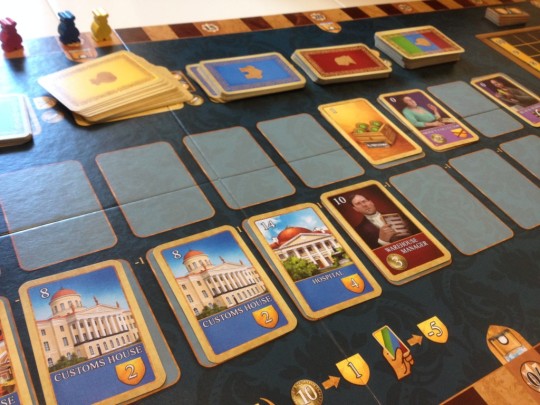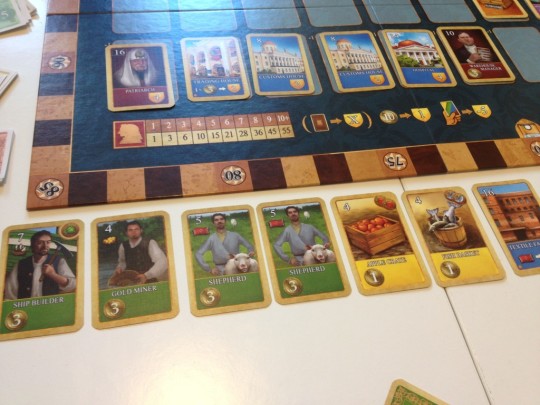Saint Petersburg (Second Edition) How to Play & Review
Saint Petersburg is a Card Drafting, Set Collection game.
Title: Saint Petersburg (Second Edition)
Year Published: 2014
Designer: Bernd Brunnhofer, Karl-Heinz Schmiel
Publisher: Z-Man Games
Players: 2-5
Game Time: ~60 mins
Set-up Time: ~5 mins
Ages: 13+
Theme: 18th Century Russia
Mechanic: Card Drafting, Set Collection
How to win: Score the most points
Game Description
On May 16th, 1703, Czar Peter laid the cornerstone for the first building in Saint Petersburg. Quickly, glorious buildings were added, always being expanded, so that Nobility (bringing victory points) may want to move in. But to accomplish this, one needs merchants who can provide the necessary Rubles, or the glory is over. The competition isn’t sleeping either, and can sometimes steal a desired card right out from under your nose.
Saint Petersburg Set-Up
Setup for Saint Petersburg is simple-ish… Once you know what you’re doing. Choose the side of the board you wish to play.
Your choices are basically with or without the Market. But, you should 100% play the game with the Market so for this overview I’ll leave it in. Just note that the Yellow cards, Food icons and Market track are ignored otherwise… The rest of the game is the same.
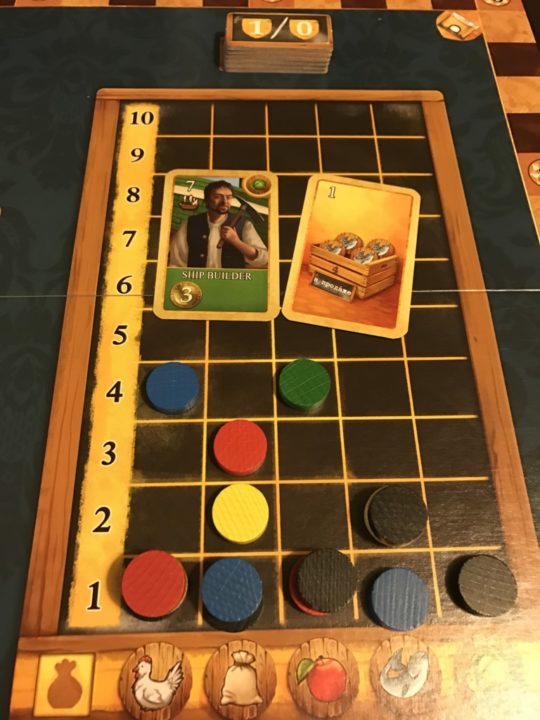
Deal the symbol cards to the players, they’re all dealt out. Some players will end up with 2 of them if you have less than 5 players. Check the rule book to see which player gets more than 1. Then replace the card with these cool golden wooden tokens.
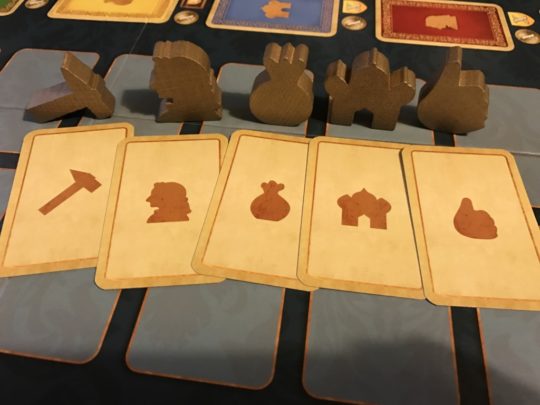
Stack the Market tiles from smallest to largest and add them above the Market. They go in their space. Put a token of each player’s colour on the bottom of each track.
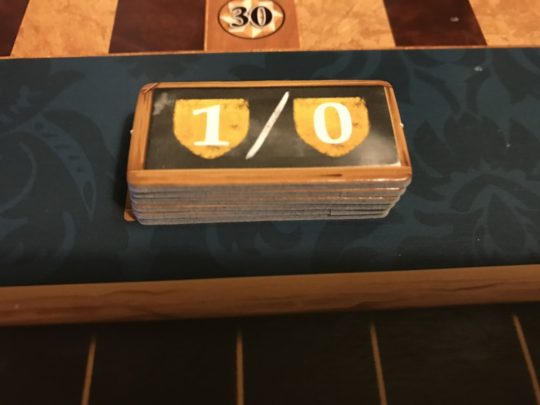
Shuffle the decks and put them on the board. Each player puts a token on zero on the score track and gets 25 Rubles. (It’s Paper money, but it’s NICE paper money)
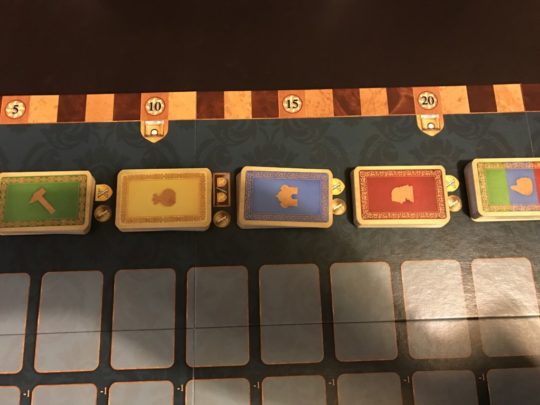
Saint Petersburg Game Play
Saint Petersburg is played over multiple rounds divided into 5 phases, one phase per deck of cards. These are (in order) Worker, Market, Building, Noble and Exchange
Worker Phase (Round 1)
The game begins as every full round does with the worker phase. It works differently in the very first round of the game.
Put 10 cards from the worker deck on the top row of the board, then sort by cost. The cost is at the top left. (I didn’t order them in the picture but eot into the habit of doing it!)
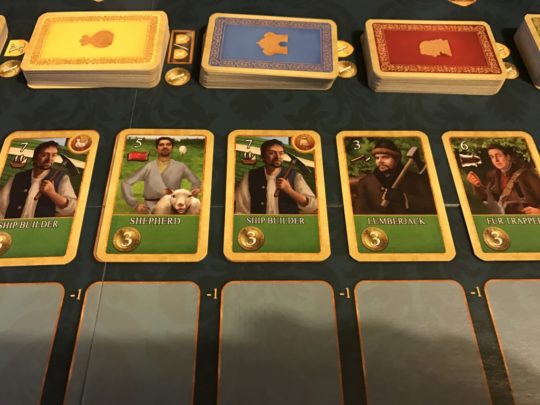
In player order, starting with the player with the Worker token, pay the cost to buy a worker. The card is placed in front of you.
Each player MUST buy a worker on their turn so all players will have 2 workers at the end of this phase. Again, you only HAVE to buy 2 in the very first round of the game.
Once each player has 2 workers, this phase ends.
Then you complete the Worker Phase Scoring and gain income from your Green worker cards. As workers give you 3 Rubles income, players will get a starting income of 6 Rubles in round 1.
If you buy a card with a Good icon in the top right, adjust the market track up or down accordingly. If it has a ?, take a token from those available and cover the ? to give it a type of Good to represent before adjusting the track.
Market Phase
Then comes the Market Phase, you put enough Market cards to fill the top row back up to 10 including any lingering workers.
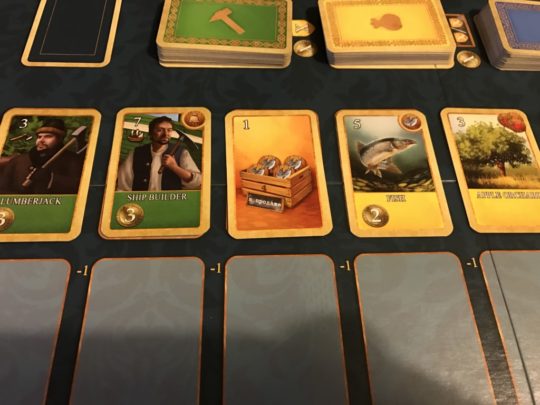
As this is where the game rounds start properly you don’t have to just buy cards, you have several options on your turn.
You have 4 possible actions and you take one on your turn, starting each round with the player with the relevant starting token and continuing clockwise.
Actions
One option though is the option to Buy a Card – Pay the cost in the top left for ANY card in the row, regardless of colour. Each card that shares a name with a card you own costs 1 Ruble less per card you have to a minimum cost of 1 Ruble.
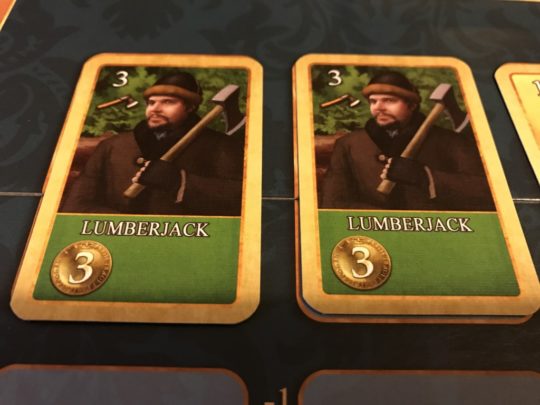
Cards that have moved down to the Second Row (more on that later) cost 1 Ruble less too but you still always pay 1 Ruble minimum.
You can Take a Card into your hand. There is a hand limit of 3 so if you already have 3 you can’t take another one.
You can Play a Card from your hand paying the cost as normal. There are some Special Purple cards which MUST be taken into hand first on one action before they can be played. Once played they are removed from the game.
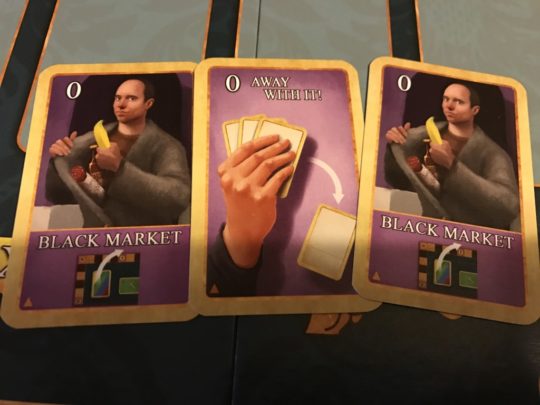
You can also Pass to drop out of the round, once everyone has passed you move on to scoring that phase.
In Market Scoring, you receive Rubles from your Yellow cards but you also score the Market tracks. For each good, score 1st and 2nd place depending on the number of goods you have equal to the numbers on the current market token. If two players are tied for first, second place isn’t scored, If two players are tied for 2nd, both players get the reward for second place.
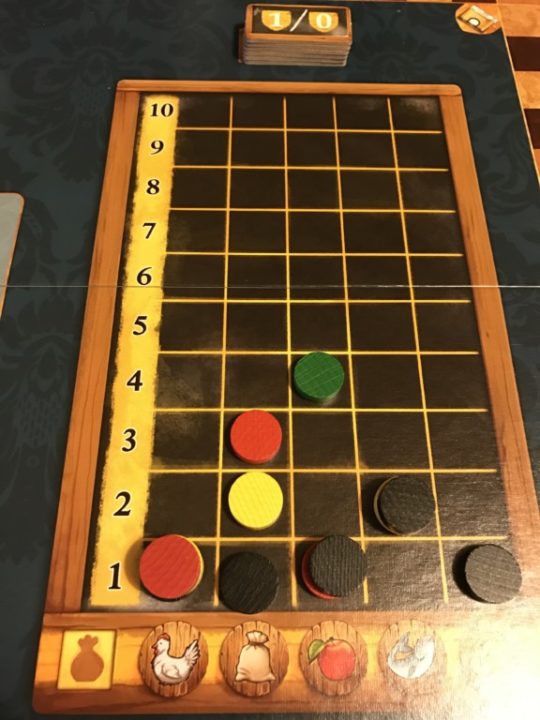
Building Phase
Then comes the Building Phase, fill up the row to 10 and start with the player with the token having the same 4 actions until everyone passes. Once again, after this phase each card that matches the Phase (in this case your Blue Building cards) will score, giving you Rubles and Victory points.
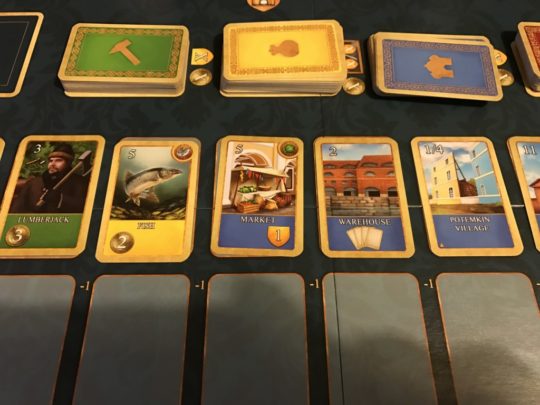
Noble Phase
Then the Noble Phase, fill up the row to 10 with Red Noble cards and continue with the start player. When everyone passes Red Noble cards will give you Rubles and/or Victory points too.

Exchange Phase
Then the Exchange phase has the same setup (fill to 10) and you have the same actions but buying these cards is a little bit different.
Exchange cards replace cards in your play area of the same colour so a Blue building card can only replace another blue Building you have in your play area. A Green worker card can only replace a worker if at least one of the symbols matches. You cannot replace other exchange cards that are already in front of you (They have a square around their cost to tell them apart) with other exchange cards but when you do exchange the cost of the new card is reduced by the cost of the card it replaces.
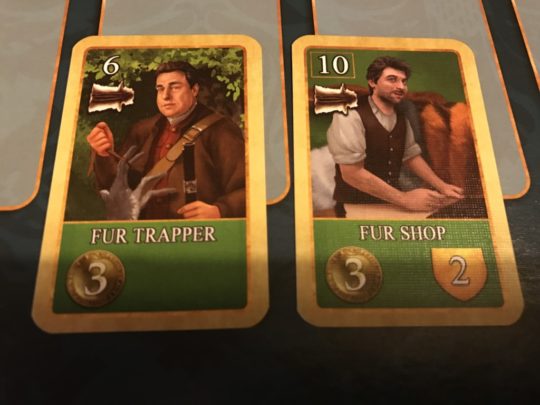
There is also no scoring after the Exchange phase.
At the end of the round unused cards are moved down to the Second Row and get that -1 discount I mentioned earlier. In future rounds, cards will already be on this bottom row so discard them first before moving the previously unwanted cards down a row.
The top market tile is returned to the box at the end of each round until the last tile is visible, that tile stays in play for the rest of the game.
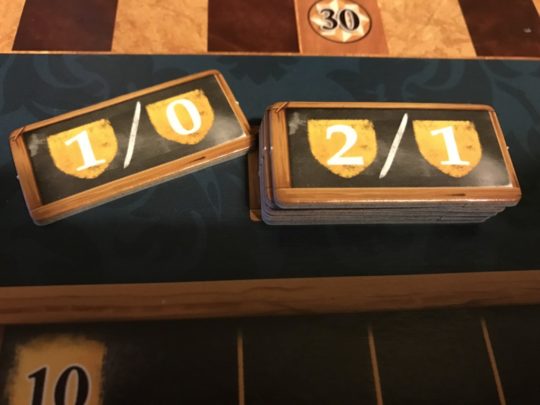
Everyone passes their wooden tokens to the player on their left and a new round starts.
Worker Phase (Round 2+)
In round 2, and for the rest of the game the Worker Phase follows the pattern of the other rounds. You fill the board up to 10 cards (including the second row) and you have the same 4 actions that you had before.
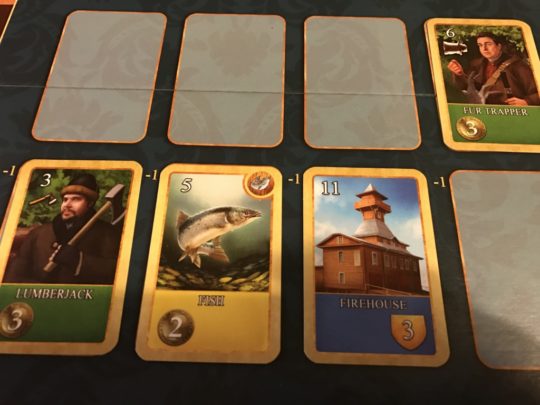
Game End
When any 1 deck of cards runs out, that will be the final round of the game. Play until after the exchange phase of the current round.
On top of the points you gained through the game you score for your unique Nobles, the more different nobles you have the more points you will gain.
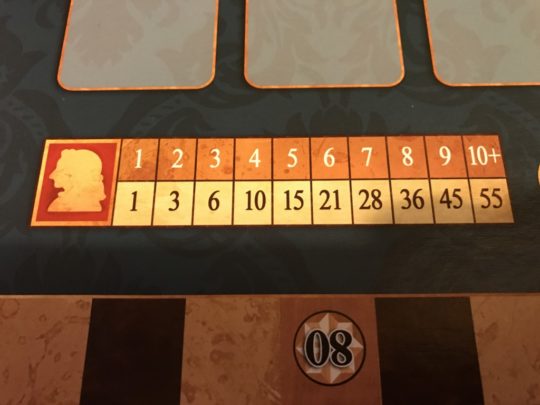
You lose 5 points for each card left in your hand.
You ‘sell’ for lack of a better phrase 10 Rubles for 1 point, it’s important to cash in Rubles this way as the most points win, but the number of leftover Rubles is used as the tiebreaker.
Round-Up
So, buy cards, build your engine to get an income of both Rubles and points and win the game.
It’s hard to explain that this game is just VERY GOOD. It sounds dull, looks dull but it feels really great to play.
It’s not as if the engine you’re building is interesting, and you are just repeating the same thing over and over but it does a great job of not feeling repetitive…
I think it’s because the things you buy and score are constantly cycling around that by the time you get around to, say, the Buildings phase again you’ve ignored them for a full round… I don’t know…
Tactical play of bringing cards into your hand is good too. Can’t afford a card now? Put it in your hand and build it later, preferably in the phase when it will score so your money is put to better use.
Money is tight!
You can’t always get the cards you want either so there is a little ‘Luck of the Draw’ I guess. Especially in the Noble phase when all the Nobles that come out you already have!
The second edition comes with a number of small expansions but I’ll let you find out about those for yourselves… I’ve played with a couple and they’re pretty interesting. (Some others I’ll never even try)
Saint Petersburg Rating
Saint Petersburg is a very fun game that everyone seems to enjoy.
I give it 8/10
Saint Petersburg First Impressions November 2015
I don’t usually buy games ‘blind’, but I did here. Did I make the right choice?
This is another one of those games that are easy to play, doesn’t take too long and makes you always feel like you’re progressing. This is the kind of game I like. Even if you’re not making the optimal move you’re always moving forward.
Money management is KEY and knowing when to take a card into your hand (The hand limit of 3 is punishing :)) and playing them is something you need to learn after several plays I think.
While we ran out of Worker and Building cards, we didn’t see half of the Noble or Exchange cards so planning for that one strategy will be almost impossible.
There are a few more mini-expansions in the box that we didn’t play with too.
All in all, a very good game, different from anything I own that I look forward to playing more.
Jesta ThaRogue


